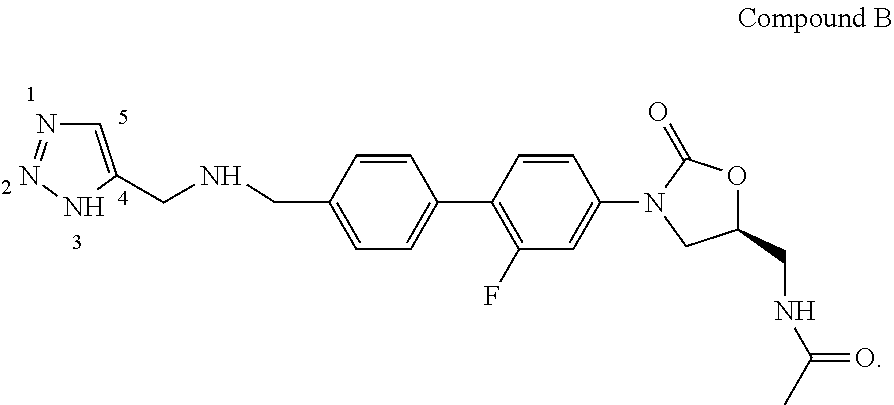Process for the synthesis of triazoles
a triazole and process technology, applied in the field of triazole synthesizing, can solve the problems of affecting the treatment effect of patients infected with such resistant bacteria, affecting the treatment effect of patients, and ultimately encountering problems with antibiotic agents developed for clinical use,
- Summary
- Abstract
- Description
- Claims
- Application Information
AI Technical Summary
Problems solved by technology
Method used
Image
Examples
example 1
Synthesis of Compound 1
[0259]Compound 1 and its hydrochloride salt are synthesized according to the following Scheme:
[0260]
[0261]4-Methoxybenzyl Azide 1001. A solution of 4-methoxybenzyl chloride 1000 (51.8 g, 331.0 mmol) in anhydrous DMF (200 mL) was treated with solid sodium azide (21.5 g, 331.0 mmol, 1.0 equiv) at 25° C., and the resulting mixture was stirred at 25° C. for 24 h. When TLC and HPLC / MS showed that the reaction was complete, the reaction mixture was quenched with H2O (400 mL) and ethyl acetate (EtOAc, 400 mL) at room temperature. The two layers were separated, and the aqueous layer was extracted with EtOAc (200 mL). The combined organic extracts were washed with H2O (2×200 mL) and saturated NaCl aqueous solution (100 mL), dried over MgSO4, and concentrated in vacuo. The crude 4-methoxybenzyl azide (51.2 g, 53.95 g theoretical, 94.9% yield) was obtained as colorless oil, which by HPLC and 1H NMR was found to be essentially pure and was directly used in the subsequent ...
example 2
Synthesis of Compound 2
[0280]Compound 2 is prepared using a reaction scheme analogous to that for compound 1, using oxazolidinone compound 1025 in place of iodide 1010.
Synthesis of Oxazolidinone Compound 1025
[0281]Oxazolidinone compound 1025 is prepared according to the following reaction scheme which is analogous to that used for the synthesis of oxazolidinone compound 1010.
[0282]
[0283](5R)-Methanesulfonic acid 3-(3-fluoro-4-iodophenyl)-2-oxo-oxazolidin-5-ylmethyl ester (1020). A solution of (5R)-3-(3-fluoro-4-iodophenyl)-5-hydroxymethyl-oxazolidin-2-one (1019, 11.66 g, 34.6 mmol) in methylene chloride (CH2Cl2, 80 mL) was treated with N,N-diisopropylethylamine (Hunig's base, DIEA, 8.95 g, 12.1 mL, 69.2 mmol, 2.0 equiv) at 25° C., and the resulting mixture was cooled down to 0-5° C. before methanesulfonyl chloride (MsCl, 4.36 g, 2.95 mL, 38.1 mmol, 1.1 equiv) was dropwise introduced into the reaction mixture at 0-5° C. under N2. The resulting reaction mixture was subsequently stirre...
example 3
Synthesis of Compound 3
[0308]Compound 3 is prepared using a reaction scheme analogous to that for compound 1, using oxazolidinone compound 1026 in place of oxazolidinone compound 1010.
Synthesis of Oxazolidinone Compound 1026
[0309]Oxazolidinone compound 1026 is prepared according to the following reaction scheme which is analogous to that used for the synthesis of oxazolidione compound 1010.
[0310]
[0311](5S)-2,2-Difluoro-N-[3-(3-fluoro-4-iodo-phenyl)-2-oxo-oxazolidin-5-ylmethyl]-acetamide (1026). A suspension of (5S)-5-Aminomethyl-3-(3-fluoro-4-iodo-phenyl)-oxazolidin-2-one (1022, 5.0 g, 14.88 mmol) in methylene chloride (CH2Cl2, 50 mL) was treated with difluoroacetic acid (2.14 g, 1.41 mL, 22.32 mmol, 1.5 equiv) and N,N-diisopropylethylamine (DIEA or Hunig's base, 3.85 g, 5.18 mL, 29.76 mmol, 2.0 equiv), and the resulting reaction mixture was cooled down to 0-5° C. before being treated with EDCI (4.30 g, 22.32 mmol, 1.5 equiv) at 0-5° C. The reaction mixture was subsequently stirred ...
PUM
 Login to View More
Login to View More Abstract
Description
Claims
Application Information
 Login to View More
Login to View More - R&D
- Intellectual Property
- Life Sciences
- Materials
- Tech Scout
- Unparalleled Data Quality
- Higher Quality Content
- 60% Fewer Hallucinations
Browse by: Latest US Patents, China's latest patents, Technical Efficacy Thesaurus, Application Domain, Technology Topic, Popular Technical Reports.
© 2025 PatSnap. All rights reserved.Legal|Privacy policy|Modern Slavery Act Transparency Statement|Sitemap|About US| Contact US: help@patsnap.com



